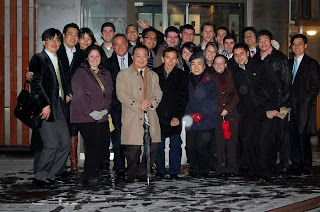It's our last day here in Seoul and what an adventure it has been. Seoul is simply an amazing city and the Korean people could not have been nicer. For as large of a city it is (12 million people), the streets and sidewalks are extremely clean and the only hint of smoggy or polluted air has been noticeable when there is a really heavy cloud cover.
As far as our students are concerned, Angie and I could not have asked for a better, more respectful group. Thank you all for being responsible, considerate, and genuine. It has been such a reward for us to spend time with all of you.
I also wanted to express our deepest thanks and appreciation to Professor and Mrs. Kang - we could not have survived this trip without you! THANK YOU for your time and patience and for showing us what this great city has to offer.
Tomorrow morning (Sunday) we depart for the airport at 7:30am. Therefore, this will probably be my last post while in Seoul. I apologize I wasn't able to upload any video - there were some technical difficulties. But, I'll try to upload them once we're back in the States. For now, I thought I would post a few more pictures from our week. Thanks for following us!
As far as our students are concerned, Angie and I could not have asked for a better, more respectful group. Thank you all for being responsible, considerate, and genuine. It has been such a reward for us to spend time with all of you.
I also wanted to express our deepest thanks and appreciation to Professor and Mrs. Kang - we could not have survived this trip without you! THANK YOU for your time and patience and for showing us what this great city has to offer.
Tomorrow morning (Sunday) we depart for the airport at 7:30am. Therefore, this will probably be my last post while in Seoul. I apologize I wasn't able to upload any video - there were some technical difficulties. But, I'll try to upload them once we're back in the States. For now, I thought I would post a few more pictures from our week. Thanks for following us!
























 It was now time to head to Kyobo Life, which is Korea’s largest life insurance company and the world’s 8th largest. Kyobo is a privately owned company that has really taken off in the last ten years. The literal translation of “Kyobo” is “Education Insurance.” The company takes this translation to heart and really tries hard to educate its clients, as well as the Korean people, with various initiatives. Kyobo Life makes up 55% of the current market share of the Big 3 Life Insurers in Korea (Samsung and Korea Life are the other two.) Kyobo is expected to grow even more in the coming years due to the demographic change of Korea. We certainly had an information-packed presentation at Kyobo and learned quite a bit about their company.
It was now time to head to Kyobo Life, which is Korea’s largest life insurance company and the world’s 8th largest. Kyobo is a privately owned company that has really taken off in the last ten years. The literal translation of “Kyobo” is “Education Insurance.” The company takes this translation to heart and really tries hard to educate its clients, as well as the Korean people, with various initiatives. Kyobo Life makes up 55% of the current market share of the Big 3 Life Insurers in Korea (Samsung and Korea Life are the other two.) Kyobo is expected to grow even more in the coming years due to the demographic change of Korea. We certainly had an information-packed presentation at Kyobo and learned quite a bit about their company.


























